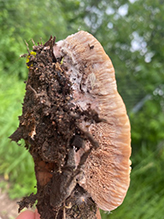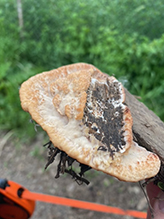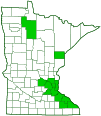Blushing Rosette
(Abortiporus biennis)
Conservation • Description • Habitat • Ecology • Distribution • Taxonomy
|
|
||||||||||||||
Description |
Blushing Rosette is a widespread, highly variable, ground-dwelling polypore. It occurs in Europe, Asia, Australia, southern Africa, and the Americas. In the United States, it occurs east of the Great Plains and west of the Rocky Mountains, with a few scattered records between. Blushing Rosette appears in summer and fall, alone or in groups but not clustered (gregarious). It grows on the ground around the base of both stumps and living deciduous trees, and occasionally around conifers. It gets its nutrients from dead and decaying wood. When found near a dead stump, it causes white rot in the dead wood. When found near a living tree, it is assumed to be growing on the roots, and it causes white trunk rot in the living wood. Blushing Rosette has two very different forms. This, and its worldwide distribution, has caused it to be described many times under many scientific names, with the result that today there are more than fifty synonyms for this species. The “normal” form takes the shape of a typical polypore, usually with a single cap, sometimes with multiple caps fused together into an overlapping rosette. The cap may be light brown, tan, reddish brown, or wine red. It is sometimes faintly concentrically zoned, and the margins are usually pale. It is usually 1¼″ to 3¼″ (3 to 9 cm) wide, but when growing alone it can be up to 8″ (20 cm) wide. It can be round, semicircular, or kidney shaped, or it can have an irregular shape, but it is always convex above and flat below (planoconvex). The upper surface is dry. It is usually densely or moderately covered with short, dense, matted, woolly hairs, but it is sometimes almost hairless. The pore surface is whitish to buff at first, but it becomes dingy with age, and it bruises pinkish to reddish brown or reddish to pinkish brown. When fresh, it sometimes exudes reddish droplets. The pores are 1⁄32″ to ⅛″ (1 to 3 mm) wide and up to 3 ⁄16″ (5 mm) deep. They appear stuffed at first, becoming angular, irregular, or maze-like as they age, and sometimes tooth-like on older specimens. The stalk may be well developed or poorly developed, or there may be no stalk. When present, the stalk is 1¼″ to 4″ (3 to 10 mm) long, and ⅜″ to 1¼″ (1 to 3 mm) thick. It may be laterally or centrally attached to the cap. It is hairy, colored like the cap, and often encrusted with dirt. The flesh is white, pinkish, or pale tan. The edibility is unknown, but it is too tough to eat. The spore print is white. The “aborted” form is an irregular mass of pore surface. It may have a single cup-like shape, or it may be cauliflower-like, with numerous separated, rounded projections. |
Similar Species |
Habitat and Hosts |
Deciduous and occasionally coniferous trees and stumps |
Ecology |
Season |
Summer and fall |
Distribution |
||
|
Sources |
|
| 7/15/2024 | ||
Occurrence |
||
Widely distributed but not common |
||
Taxonomy |
|
| Kingdom | Fungi (fungi) |
| Subkingdom | Dikarya |
| Phylum | Basidiomycota (club fungi) |
| Subphylum | Agaricomycotina (jelly fungi, yeasts, and mushrooms) |
| Class | Agaricomycetes (mushrooms, bracket fungi, puffballs, and allies) |
| Subclass | incertae sedis (uncertain placement) |
| Order | Polyporales (shelf fungi) |
Family |
Podoscyphaceae |
Genus |
Abortiporus |
|
|
Family |
|
Subordinate Taxa |
|
|
|
Synonyms |
|
Abortiporus biennis var. biennis Abortiporus biennis var. sowerbyi Abortiporus distortus Agaricus coriaceus Bjerkandera puberula Boletus biennis Boletus distortus Ceriomyces alveolatus Daedalea biennis Daedalea bonariensis Daedalea distorta Daedalea heteropora Daedalea pampeana Daedalea polymorpha Daedalea puberula Daedalea sericella Grifola biennis Heteroporus biennis Heteroporus distortus Hydnum bienne Irpex hydniformis Irpicium ulmicola Lentinus bostonensis Lentinus coriaceus Lentinus hispidosus Lentinus lusitanicus Merisma heteroporum Merisma heteroporus Phaeolus biennis Pocillaria coriacea Polyporus biennis var. distortus Polyporus biennis var. sowerbyi Polyporus biennis Polyporus distortus Polyporus heteroporus Polyporus occultus Polyporus proteiporus Polyporus rufescens Polyporus sericellus Polystictus rufescens Ptychogaster alveolatus Sistotrema bienne Sistotrema lobatum Sistotrema rufescens Sistotrema rufescens ssp. bienne Sistotrema rufescens ssp. rufescens Sistotrema rufescens var. rufescens Spongiosus rufescens Striglia puberula Trametes rufescens Tyrodon repandus ssp. rufescens |
|
Common Names |
|
Blushing Rosette |
|
Glossary
Saprobic
A term often used for saprotrophic fungi. Referring to fungi that obtain their nutrients from decayed organic matter.
Visitor Photos |
||
Share your photo of this fungus. |
||
This button not working for you? |
||
Matthew Knott |
||
 |
 |
|
uploaded to iNaturalist.org |
|
|
MinnesotaSeasons.com Photos |
||
|
||
|
||

Slideshows |
|

Visitor Videos |
||
Share your video of this fungus. |
||
This button not working for you? |
||
|
Other Videos |
||
Abortiporus biennis Greece by Theo |
About
Dec 16, 2022 Abortiporus biennis is a species of fungus belonging to the family Meruliaceae. |
Abortiporus biennis. Champimaginatis. English Text |
About
Jun 13, 2023 The photos and videos of Champimaginatis do not constitute a tool for identifying mushrooms for consumption. |
Periode 8 Abortiporus Biennis |
About
May 30, 2014 Beschrijving |

Visitor Sightings |
||
Report a sighting of this fungus. |
||
This button not working for you? |
||
Matthew Knott |
Location: Spafford Park, Cloquet, Minnesota uploaded to iNaturalist.org |
 |
MinnesotaSeasons.com Sightings |
||
|

|
Created: 7/15/2024 Last Updated: © MinnesotaSeasons.com. All rights reserved. |
